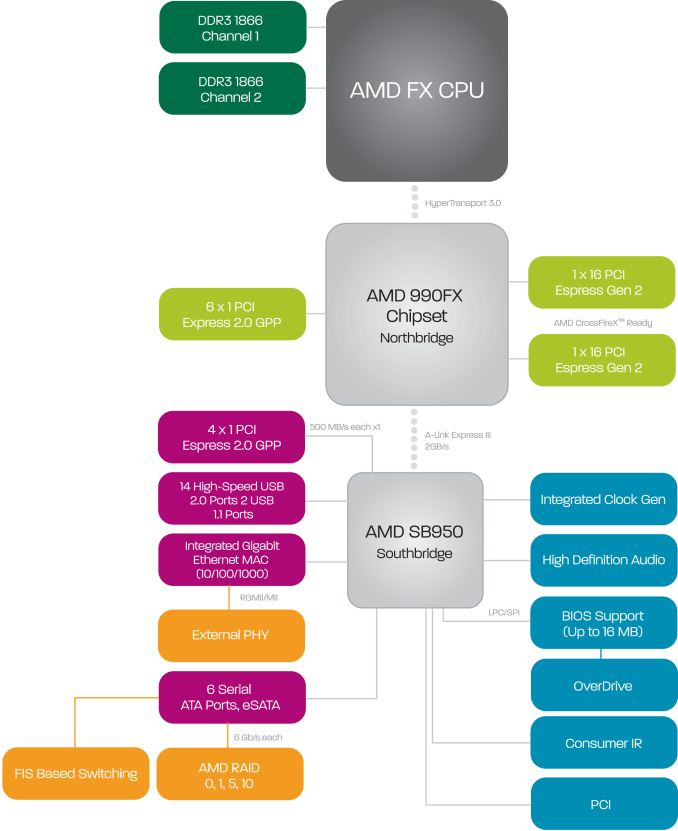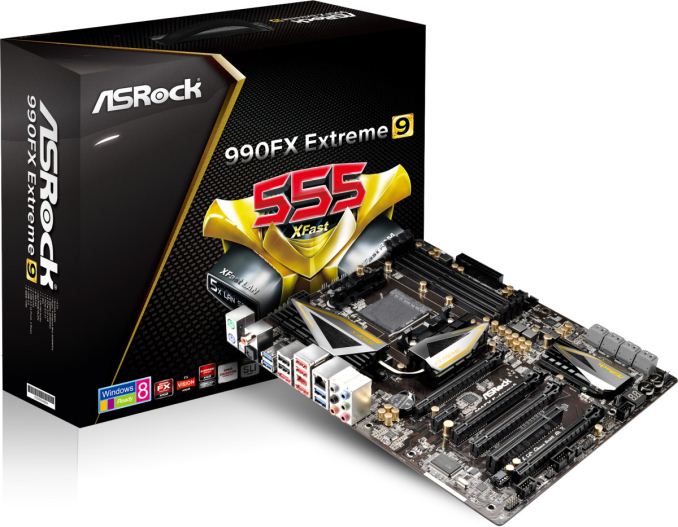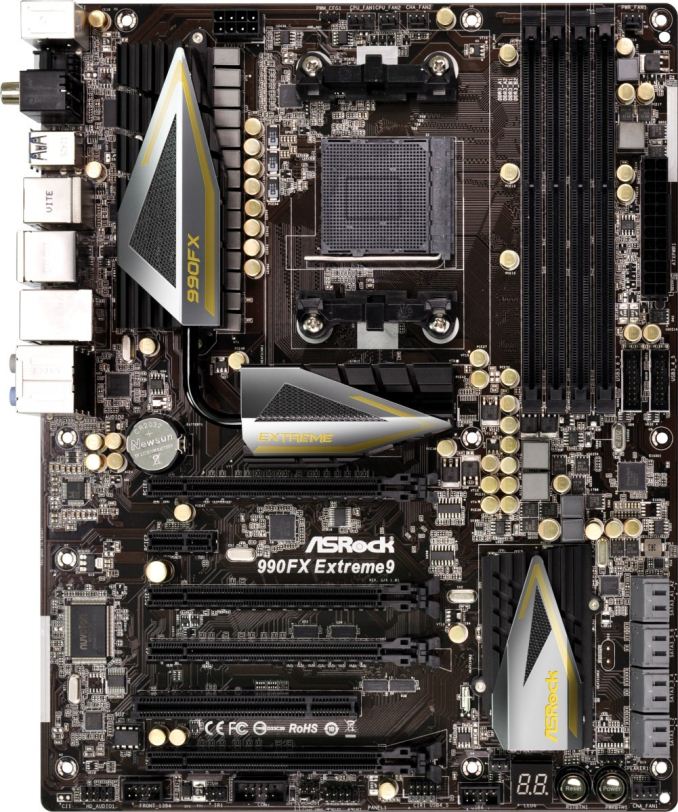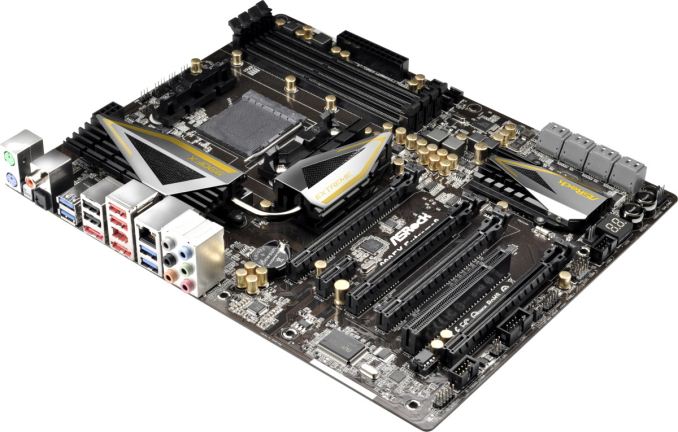AMD’s 5 GHz Turbo CPU in Retail: The FX-9590 and ASRock 990FX Extreme9 Review
by Ian Cutress on August 9, 2014 8:00 AM ESTFor new users to the PC industry, or those that migrated towards newer APU platforms, it is worth going back and recalling the AM3+ socket with the 990FX chipset. When the platform was released, it offered several advantages that Intel lacked at the time: a full set of SATA 6 Gbps ports was the main advantage which took Intel another two generations to offer. The chipset, with the right CPU, also offered substantially more PCIe lanes than the mainstream Intel parts which were similarly priced. While the user could have sixteen PCIe 2.0 lanes from an Intel CPU for graphics coupled with eight PCIe 2.0 lanes from the chipset, AMD users had 32 PCIe 2.0 lanes from the CPU for graphics, another six PCIe 2.0 x1 lanes for controllers and four PCIe 2.0 x1 lanes from the chipset. This gave the AMD motherboard manufacturers more bandwidth to add extra ports or adjust their PCIe layout for graphics. Note that this is the latest AMD platform to support SLI, rather than the newer FM1/FM2 platforms that do not.
There are a few limitations on the 990FX chipset worth mentioning. When this motherboard we are testing today was released, PCIe 3.0 was gaining momentum. The only way to add PCIe 3.0 to these motherboards was to integrate a PLX chip between the Northbridge and the GPUs which gave PCIe 3.0 capabilities between the GPUs, but it still limited data transfer between the PLX chip and the CPU to PCIe 2.0. The other limitation was one of cost. AMD platforms have historically been low cost markets, at least for end users, which correlates to a reluctance to expand spending on motherboards. This reduces the market for high end motherboard solutions which might incorporate extra features and controllers, and as a result many AM3+ motherboards were aimed at price/performance rather than feature set.
The ASRock 990FX Extreme9 sits near the top of the stack for feature set, and currently retails for $170. To put that into perspective, we discuss $170 motherboards for Intel’s latest chipsets as a mid-range point rather than the high end.
Also worth noting that because our last 990FX reviews were with the FX-8150 processor, in order to compare to historical data we also used the Extreme9 with the FX-8150 for comparison points.
ASRock 990FX Extreme9 Overview
Visual Inspection
Taking the motherboard out of the box for the first time and there are several items worth noting. Firstly the extended heatsink which covers the 12+2 phase power delivery to the side of the socket and the North Bridge just below the socket. ASRock has placed all the power delivery chokes in a line, and uses a CHIL8328 IC for a digital design. This PWM controller powers 6-8 phases, and thus the system uses multiplexing to get the desired 12 for the CPU voltage.
The socket area has four fan headers within immediate reach – two CPU and one chassis header directly above the socket, and a 3-pin PWR header to the top right of the DRAM slots. The other two fan headers on the motherboard are located at the bottom, one to the left of the 2-digit debug and the other to the right of the power/reset buttons. The socket area uses a low heatsink profile combined with a gap to the DRAM that should allow for large air coolers to be used.
The DRAM slots use double sided latch mechanisms and there is ample space to the first major PCIe slot. At the bottom of the DRAM slots, to the right, are two USB 3.0 headers from an Etron EJ188H controller. At the time this motherboard was made, a chassis may have had one USB 3.0 header, and thus ASRock also includes a USB 3.0 panel in the box.
Underneath this are eight SATA 6 Gbps ports, the top two from an ASMedia ASM1061 controller followed by six from the south bridge. In this situation, with an additional controller, I would have preferred if ASRock had used a different color for the ASMedia ports. Below these is a fan header, the power and reset buttons, and the two-digit debug.
At the bottom of the motherboard is an IEEE1394 header, a COM header, two USB 2.0 headers, an IR header and the front panel headers. Above this is the odd PCIe layout, which combines the 32 PCIe 2.0 lanes from the north bridge with another PCIe 2.0 x4.
The layout is such that the top PCIe slot is an x16, followed by an x1. The second full length slot is a PCIe 2.0 x4, followed by another PCIe 2.0 x16. This slot shares bandwidth with the bottom PCIe slot, whereby if the bottom is populated, they both go to PCIe 2.0 x8. There is also a PCI slot near the bottom.
This means:
Configuration 1: x16/x1/x4/x16/PCI/-
Configuration 2: x16/x1/x4/x8/PCI/x8
Having this layout allows the user to equip the board with three GPUs in the first, third and fourth full length slots. If they are double slot cards, the PCIe 2.0 x4 is left vacant for a sound card, network card, RAID card or other PCIe device. It is worth noting that in terms of audio, ASRock has equipped this motherboard with a Realtek ALC898 codec.
The rear panel uses two PS/2 ports, one for mouse and one for keyboard, followed by a ClearCMOS button and SPDIF outputs. The four blue USB 3.0 ports are powered by another Etron EJ188H controller, and the panel also has four USB 2.0 ports with two eSATA 6 Gbps ports. The IEEE1394 port on the rear is perhaps one of the last consumer oriented motherboard to have this port pre-installed. The Intel NIC on the rear IO might seem a little strange on an AMD motherboard, but this is one of the top line 990FX solutions. The audio jacks round off the set.
Board Features
| Board Features | |
| Price | US (Newegg) |
| Size | ATX |
| CPU Interface | Socket AM3+ |
| Chipset | 990FX + SB950 |
| Memory Slots |
Four DDR3 DIMM slots supporting up to 32 GB Up to Dual Channel, 1066-2450 MHz |
| Video Outputs | None |
| Onboard LAN | Intel 82583V |
| Onboard Audio | Realtek ALC898 |
| Expansion Slots |
3 x PCIe 2.0 x16 (x16/x16/- or x16/x8/x8) 1 x PCIe 2.0 x4 1 x PCIe 2.0 x1 1 x PCI |
| Onboard SATA/RAID |
6 x SATA 6 Gbps (Chipset), RAID 0,1,5,10 2 x SATA 6 Gbps (ASMedia ASM1061) |
| USB 3.0 |
4 x Rear USB 3.0 (Etron EJ188H) 2 x USB 3.0 Headers (Etron EJ188H) |
| Onboard |
8 x SATA 6 Gbps Ports 2 x USB 3.0 Headers 2 x USB 2.0 Headers 6 x Fan Headers 1 x COM Header Power/Reset Switches Dr. Debug LED Front Panel Connector Front Audio Connector |
| Power Connectors |
1 x 24-pin ATX 1 x 8-pin CPU |
| Fan Headers |
2 x CPU (4-pin, 3-pin) 3 x CHA (4-pin, 2x 3-pin) 1 x PWR (3-pin) |
| IO Panel |
1 x PS/2 Keyboard 1 x PS/2 Mouse 4 x USB 2.0 4 x USB 3.0 2 x eSATA 6 Gbps 1 x IEEE1394 1 x Intel NIC Clear CMOS Switch Audio Jacks |
| Warranty Period | 3 Years |
| Product Page | Link |
If we were making a high end AMD motherboard for 2014, the extra lanes would be perfect for PCIe storage. Pile on a SATA Express and M.2 x4 slot without losing lanes to other functions. Some native USB 3.0 would be nice, or 3.1 via controllers. PCIe 3.0 support would be a must of course, along with a Realtek ALC1150 or more advanced audio codec. ASRock’s latest motherboards have featured a water-proof/superhydrophobic coating, or small LCD panels to aid in overclocks, which might be something in AMD meets 2014.















146 Comments
View All Comments
just4U - Monday, August 11, 2014 - link
I think coolermaster makes it.. Not bad, not great.. You'd be better served getting the the variant without liquid cooling (I think..) and than deciding on your own what you need.Natfly - Tuesday, August 12, 2014 - link
Garbage....you can't polish a turd.The_Riddick - Wednesday, August 13, 2014 - link
These processors really need to be running at below Intel wattage in order to be competitive, even if they tried and sold me one of these cpus for $10 I wouldn't buy one. 220W and performs worse then i5, no thanks.TiGr1982 - Wednesday, August 13, 2014 - link
Well, this same FX Piledriver certainly can run below Intel wattage (say, around 70 W for the CPU itself), but only at no more than 2.5-3.0 GHz frequency - like Opterons 6300 do.Then, it won't make a lot of sense on the desktop either :)
eanazag - Friday, August 15, 2014 - link
AMD misunderstood me.Before this product was initially released as an OEM part I had posted on an AMD article that I would be interested in a 200 W APU not CPU. I wouldn't mind an APU that could clock the GPU and CPU outrageously. I have a 300 W video card plus a 105 W Intel CPU, which the CPU is supposed to be 95 W. So a 200 W APU that comes close to both of those is a cost savings if it will clock down while idle. Plus space and heat savings.
Evidently they opted for doing it with this CPU. This is not totally bad, but between the pricing, performance, chipset features, and efficiency versus the 8350 and Intel parts it is really tough to justify. I saw numbers in there for workloads where the Haswell i3 is more than the 9590. I bought the Phenom 9600 with the errata and the CPU was fine, but I am still not willing to go that far in loyalty to AMD on the CPU side anymore. They would do better to just import the 8350/9590 silicon onto their 28 nm process. So what if it takes a clock regression as it will also have a TDP drop. They really need to do a better job updating their chipsets. This is less forgivable than their CPU line. That old, crappy 9590 would look better with a new chipset (PCIe 3 at least).
0ldman79 - Monday, August 18, 2014 - link
I've been running AMD in my desktops as a primary since the K6-2 (and K6-3+ mobile in a desktop if anyone remembers that gem).That being said, I have to call the current generation as AMD's version of the Pentium 4. I have an FX6300 in my main gaming PC. While it does well, it just isn't up to par with Intel's offerings.
I've been keeping an eye out for the next version of the AM3+ performance line and found that I've pretty much got it.
Uh... what?
AMD's flagship performance socket, AM3, has pretty much been dropped completely with all focus towards hot dual cores (seriously, that is what they are) with some rather nice integrated graphics. While I've sold several of these to my business customers I'm seriously considering jumping to Intel for my rigs.
The biggest reason is I've always had an upgrade path with AMD. It was always easy to keep building a new AMD as I'd have a couple of generations of CPU available to a platform and some of my parts from the previous system would cross. It was rarely ever a 100% replacement, more a long term evolution.
My next system will likely require a new motherboard to replace what is to me a fairly new board. With AMD effectively dropping the AM3 line just after I got onboard, I've got a sour taste in my mouth.
Those Core i7 are looking better. AMD has done this to themselves.
They took their IT customers, those that tell everyone else what to buy, told them about this awesome new CPU on the AM3 platform, the ultimate of the Bulldozer line, walked them out blindfolded for the big reveal, then walked away. We're standing there in a field of nothing with a blindfold on looking like jackasses.
That is what I think of AMD's current roadmap.
Cryio - Tuesday, August 19, 2014 - link
The absolutely BEST game for CPU benchmarking remains Crysis 3.I don't know why they use Tomb Raider and Company of Heroes which both are CPU agnostic. Not to mention that F1 series just hates AMD CPUs for whatever reason.
Games that really use the CPU: Crysis 3, Hitman Absolution, Assassin's Creed IV (I think). GRID 2, or really any mainline DIRT games. Hell, even Watch Dogs.
If any of those games that know how to properly use more than 2-4 cores were tested then this AMD beast would wipe the floor with those i3s.
Budburnicus - Wednesday, January 14, 2015 - link
LMAO!Just laughing at "This AMD "beast" would wipe the floor with those i3s." - You used beast to describe AMD's flagship product, and then talked about proper software coding allowing it to wipe the floor - wiiith i3s! LOL! just LOL!
I really am not sure if you were being sarcastic or actually meant that, but I hope it was sarcasm!
nctritech - Monday, October 20, 2014 - link
I just got an FX-9590 and an ASUS M5A99FX PRO R2.0 motherboard to go with it. I closely examined available Intel options and chose this chip. Most of the comments here put down this chip and AMD because Intel has higher-performing options and most of those comments are completely missing one vital factor: PRICE. I got this combo for $355 tax + shipping. Even if you go with the previous generation of Intel's flagship CPU, the i7-3770K, Newegg has them TODAY for $330. Hmm, that's almost as much as I paid for the FX with a brand new motherboard! Same story for the i7-4770K at $335.I walked away during a CPU sale special paying $220 total for the FX-9590 chip. It's faster in video compression benchmarks than EVERY desktop Intel chip EXCEPT the X-series i7 chips. It runs with or near the 3770K and 4770K in almost every other benchmark, possibly excluding games.
For those of you jeering at "efficiency" and praising how much faster Intel's Haswell chips can be, I wish you the best...but I'll be able to get an SSD, better RAM, or a nicer graphics card because I have $100 extra in my pocket, all while enjoying roughly the same performance as the Intel chips you've formed a cult around. Best of all, there's no LGA socket with extremely fragile pins to void my warranty; you know, when you return a mobo and they refuse to honor your return because "user-caused CPU socket pin damage" even though it was sent back because a nearby defective power component visibly burned up. Plus, did you know that CPUs only use their TDP worth of heat when you're taxing them to the maximum constantly? Who knew?!
You can have your lower performance-per-currency-unit chips and theoretical efficiency, I'll take the best overall deal, thanks!
Jinx50 - Sunday, November 2, 2014 - link
I agree enthusiast's are rarely concerned with power consumption. I quote a user i encountered who stated My Haswell is more energy efficient "meanwhile they have their rig picture with 3 Titans running in 3 way SLI for their avatar". Pure derp and a grasping desperately for the one and only straw they have in regards to downplaying the FX lineup. It's obviously neither price or performance, or multitasking for that matter.I've just become accustomed to tuning them out like annoying kids at the pub.